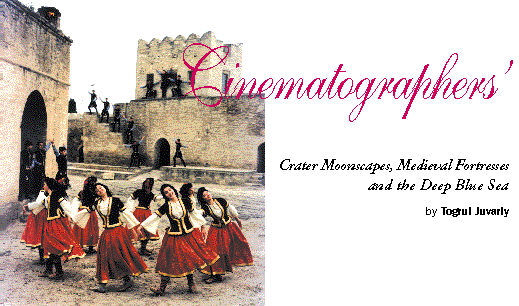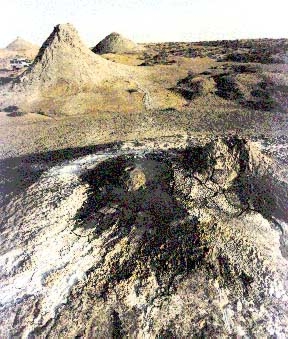|

Autumn 1997 (5.3)
Pages 52-53

Well, we don't have jungles
in Azerbaijan to serve as backdrops for fimmakers. Nor will you
find icebergs or deserts. But in most other respects, my tiny
little country provides an extraordinary range of exotic landscapes
and cityscapes for cinematographers. It's often said that Azerbaijan
has nine of the world's eleven major climactic zones. You'll
find everything here except the extremes-no frigid Arctic climes,
no scorching tropics. But high on the mountain ridges of the
Caucasus, you'll find icy landscapes. And the plains and some
of our southern regions where tea and rice are grown are considered
sub-tropical.
Sometimes, even aspects of our landscape that we don't consider
especially inviting tantalize filmmakers. Many years ago, I was
traveling with some Hungarian cinematographers between Baku and
the town of Shamakhi, about an hour west of the capital. There
is quite a long stretch along the road where all you can see
is barren, uninhabited, scruffy hills. The sight always saddens
and depresses us, but, surprisingly, it absolutely delighted
these foreigners. They jumped out of the car and started pretending
they were shooting their movie cameras. They scattered to the
hills, looking like characters right out of a scene from the
Bible.
Below: Azerbaijan is known to have more
mud volcanoes than any other country in the world.
  Barren landscapes Barren landscapes
I thought of them several years later when the great Italian
Michaelangelo Antonioni came to Baku in search of a setting for
one of his films. Born in 1912, Antonioni went on to become a
classic filmmaker known for using film as a metaphor, rather
than a mirror of reality. In the Soviet Union, he didn't always
get the support he wanted, and I remember how he used to threaten
the cinema bureaucrats, saying that he would call on his friend,
the Shah of Iran, to provide a helicopter to hasten his search.
Antonioni, too, was struck by our uninhabited landscapes.
Another place that struck his imagination was the exotic Sufi
Hamid cemetery located about an hour's drive out of Baku. From
olden days, this graveyard was considered sacred, but beyond
that, there's a mysterious magic about the aesthetics there.
A white sculptured camel stands enclosed in a courtyard next
to a small white-washed mosque. Outside, there are hundreds of
hand-painted bas-relief tombstones, mostly in pastels-quite unlike
anything else in the world. Objects carved on the gravestones,
such as samovars, jewelry, sewing machines, worry beads, even
cars symbolize the life of the deceased person.
In fact, Antonioni started making plans to shoot a film there.
But his ideas were so removed from Soviet reality that it soon
became evident that he wouldn't get the cooperation he needed
to do it. That was back then; too bad, he's not here trying to
film today. Also, Tonio Guerra, his screenwriter, came along,
and he, too, became fascinated with the landscapes, especially
on the Absheron peninsula on the outskirts of Baku, where thousands
of creaky, old, rusted out oil pumps-those nodding "donkeys"-clutter
the barren, moonscape-cratered landscape. Some of those pumps
date back nearly to the turn of the century. They weren't able
to film them, but Tonio later went on to write about them.
Unfortunately, visits to Baku by some very distinguished cinematographers
have not always become fixed in film. In November 1926, the classic
filmmaker Sergey Eisenstein (1898-1948) came down to Baku to
explore the possibility of shooting some footage in the plains
for his film "General Line." But, it didn't happen.
Then, in 1930, a well-known documentary film producer, Yoris
Ivens, visited Baku. Unfortunately, he didn't end up shooting
anything here either. But Dzigi Vertov, who became known for
directing daring documentary films, used to shoot quite a bit
in Baku.
  Baku in Film Baku in Film
Photo: City Hall in Central Baku, like many
other buildings constructed at the turn of the century, is based
on European architecture.
Baku and the Absheron
peninsula, on which the capital is situated, are another subject
for conversation. Baku's charm always manages to mesmerize. Maybe
it's the proximity to the sea. Maybe it's the juxtaposition of
the medieval inner city next to the glorious architectural monuments
and palaces of the oil barons built at the turn of last century.
Each one has its own peculiar characteristic, on the one hand,
clearly European; on the other, decidedly Eastern. Despite the
fact that the capital has roots in medieval history, its shape
and image seem always to be changing. These days many of the
glorious old buildings are being refurbished and restored to
their original glory after decades of neglect and accumulated
grime.
Old "Inner
City"
Cinematographers have a tendency to gravitate towards the old
part of the city-"Ichari Shahar" (Inner City), which
is surrounded by a citadel wall. Laden with history, its narrow,
winding lanes are extremely picturesque with enclosed balconies
extending out over the narrow streets intended for pedestrians
and pack animals of a different era, certainly not for modern
day traffic. People born here are proud to call themselves "Ichari
Shaharians." One of them, Arif Balayev, became a film producer
and as you can imagine, his films are vivid with Inner City scenes.
"Ichari Shahar" also provided the backdrop for the
outstanding producer Sergey Parajanov, an Armenian from Tbilisi
[Georgia]. He filmed an Azerbaijan tale, "Ashug Garib"
there. It seemed like half of the city came out to watch him
film. Even in 1989, when the Nagorno-Karabakh conflict had already
begun and tensions were building between Azerbaijanis and Armenians,
he still proceeded with his work.
Sometimes cinematographers use Baku's villas and palaces of millionaires
built at the beginning of the century. For example, the 1945
version of "Arshin Mal Alan" (Cloth Peddler) is one
such film that became very famous and even won the "Stalin
Prize." Many of the scenes for "Mashadi Ibad"
(If Not This One, Then That One) were shot in one of the old
bathhouses of Baku. Built at the turn of the century, several
of these old public bath houses like Fantasia are extremely attractive
inside.
The most recent attempt of capturing "Ichari Shahar"
as a cinematographic backdrop was done by Ayaz Salayev in his
film "Bat," which is on tour traveling all around the
world for the past year and a half.
Maiden's Tower
Of course, there's always Maiden's Tower-the 12th century fortress
that stands as a landmark for the city of Baku. Climb up the
winding steep circular stone-hewn stairway to the roof, and you'll
find an extraordinary panoramic view of the city and sea.
"In a Southern Town" (produced by Rustam Ibrahimbeyov,
Eldar Guliyev and Rasim Ojagov, 1969) had its setting in one
of Baku's suburbs on the Khrebtov streets. [See Interview with
Rustam Ibrahim-beyov-Censorship] for the difficulties they had
in getting the film produced. People from Baku thought the film
depicted Azerbaijanis as uncivilized when what the screenwriter
really intended to show was that a person's environment can cause
him to do things counter to his beliefs and his nature. "Southern
Town" was one of the first movies to challenge the Soviet
system.
Battle Scenes on
the Sea
Another setting that should not be forgotten was a basin, built
close to the seashore at Shikhov. This used to provide a backdrop
for filming battles at sea and shipwrecks. Only two such sites
existed in all of the Soviet Union. Unfortunately, this basin
has long since been flooded by the perennial rising of the Caspian
Sea. Alexander Ptushko used to shoot films there. He was one
of the "fathers" of Russian cinema and fairy tales.
He made his first feature film with puppets in 1935.
Caucasus Villages
There are many other places in Azerbaijan that filmmakers, especially
foreigners, have yet to shoot. There are remote mountain villages
in the Caucasus so difficult to reach that roads are impassable
much of the year.
Then there's the quaint picturesque town of Shaki with its 18th
century residential palace of the khans. The town, long a center
for silk production, has its own charm. One of the most photogenic
locales is the restored caravansary that once was a bustling
center of the ancient Silk Route and which now has been converted
into a hotel.
The Gobustan Caves, about 30 miles outside of Baku provides evidence
that human beings inhabited this region at least 5,000 years
earlier. Then there's the numerous fortresses that still exist
throughout the countryside-some in better condition than others.
The list could go on.
Azerbaijan has its own charm and mysteriousness. Numerous landscapes
and cityscapes are unique and cannot be duplicated anyplace else
in the world. Azerbaijan has yet to be seriously discovered by
the international filming community, we hope now with our independence
that all this will change.
From Azerbaijan International (5.3) Autumn 1997.
© Azerbaijan International 1997. All rights reserved.
Back to Index
AI 5.3 (Autumn 1997)
AI Home | Magazine
Choice
| Topics
| Store
| Contact
us
|



